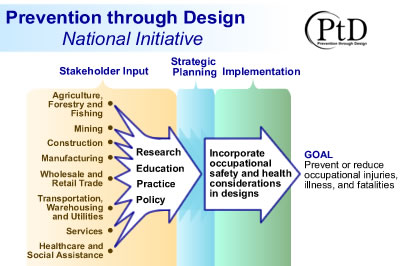Back to Basics is a weekly feature that highlights important but possibly overlooked information that any EHS professional should know. This week, we examine Prevention through Design.
The goal of the safety professional is to minimize risk and reduce harm in the workplace as efficiently and effectively as possible. Leadership can eliminate hazards at each stage planning and production by following the hierarchy of controls. Designing out risks is one of the best ways to prevent occupational injuries, and NIOSH recommends this method in its Prevention through Design (PtD) initiative.
Defining terms
According to NIOSH, PtD encompasses all of the efforts to anticipate and design out hazards to workers in facilities, work methods, operations, processes, equipment, tools, products, new technologies, and the organization of work. The focus of PtD is on workers who execute the designs or have to work with the products of the design.
The initiative was developed to support designing out hazards, which is the most reliable and effective type of prevention. PtD is important to keep in mind in all business decisions, and it requires planning and buy-in from the top-down for the most effective implementation.
Program mission
The mission of NIOSH’s Prevention Through Design National Initiative is to prevent or reduce occupational injuries, illnesses, and fatalities through the inclusion of prevention considerations in all designs that impact workers. According to NIOSH, this mission can be achieved by taking the following three steps, which will provide a vital framework for saving lives and preventing work-related injuries and illnesses:
- Eliminate hazards and controlling risks to workers to an acceptable level “at the source” or as early as possible in the life cycle of items or workplaces.
- Include design, redesign, and retrofit of new and existing work premises, structures, tools, facilities, equipment, machinery, products, substances, work processes, and the organization of work.
- Enhance the work environment through the inclusion of prevention methods in all designs that impact workers and others on the premises.
Approach to PtD
The approach that NIOSH uses to develop and implement the PtD National Initiative is framed by the industry sector within four functional areas: research, education, practice, and policy. The process encourages stakeholder input through a sector-based approach consistent with the one used under the National Occupational Research Agenda (NORA).
The research area establishes the valued of adopted PtD interventions, and focuses on the following aspects:
- Design factors that reduce occupational morbidity, mortality, and injury
- Metrics that assess the impact of the design factors
- Methods that diffuse effective designs
- Economic and business issues
The economic and business issues portion includes financial analysis of the impact of PtD on the business process.
The education pillar focuses on motivating and equipping professional communities to continually increase their knowledge of design features that have a positive impact on worker safety and health. Making business leaders aware of the potential for increasing company profitability by incorporating PtD methods in their systems and processes is also an important component.
The practice goal focuses on identifying and sharing successful procedures, processes, equipment, tools, and results through online databases and other media. It also includes demonstrating the value of including workers’ health and safety considerations in design decisions and exploring links with the movements towards green and sustainable design.
The policy aspect focuses on creating demand for safe designs for workers and incorporating these safety and health considerations into guidance, regulations, recommendations, operating procedures, and standards.
The overarching goal of the PtD National Initiative is to prevent or reduce workplace injuries, illnesses, and fatalities, and along the way, intermediate goals will be identified to provide a path toward achieving that ultimate goal. NIOSH has established the Initiative, but it is the job of partners and stakeholders to implement PtD in their workplaces to make it a standard practice in running a business.
For more information, visit NIOSH’s PtD program page here.


